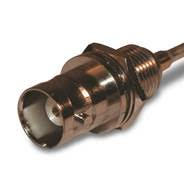
Airplanes have complex electrical systems that require a variety of different connectors. You might be surprised to learn that radio frequency (RF) connectors are used in airplanes. While commonly associated with the telecommunications industry, RF connectors have found their way into other industries, including the aerospace industry. Many airplanes now feature RF connectors.
What Are RF Connectors?
RF connectors are electrical connectors that are designed to accommodate radio frequency-carrying cables. Coaxial cables, for instance, are often fitted with an RF connector. They preserve the shielding of coaxial cables better than that of other connectors. There are also special types of RF connectors that are designed to minimize signal reflection. Regardless, all RF connectors are electrical connectors for RF-carrying cables like coaxial cables.
RF connectors are easy to use. Some of them require nothing more than twisting. You can twist some types of RF connector onto the end of a coaxial cable. Other types feature a brace or bayonet-style fastening mechanism. The bottom line is that RF connectors are easy to use.
Antenna Wiring
Airplanes use RF connectors for antenna wiring. All airplanes have antennas. Most airplanes, in fact, feature three different types of antennas: Dipole, Marconi and Loop. Antennas are receivers of radio frequency-transmitted data. It receives radio waves in the air so that they can be interpreted by a device. Most airplanes have three separate antennas,
Antenna wiring typically requires the use of RF connectors. As previously mentioned, antennas are receivers of radio frequency-transmitted data. Therefore, they are connected to devices with coaxial cables. Coaxial cables may connect an airplane’s radio system to its antennas, and coaxial cables require RF connectors.
Airplanes may use RF connectors for other types of cables. In the aerospace industry, though, RF connectors are most commonly used for antenna wiring. All three types of antennas — Dipole, Marconi and Loop — must be wired. Coaxial cable with RF connectors is a common wiring solution for these antennas.
RF connectors allow for two-way radios with airplanes. When flying, pilots can communicate with air traffic controllers using a two-way radio. Two-way radios leverage an antenna and radio system with multiple RF connectors.
In Conclusion
RF connectors aren’t used strictly for television, networking and other telecommunications applications; they are used in aerospace applications as well. Most airplanes feature coaxial cable with RF connectors for their respective antennas. RF connectors support radio frequency, making them ideal for antenna applications such as this.



